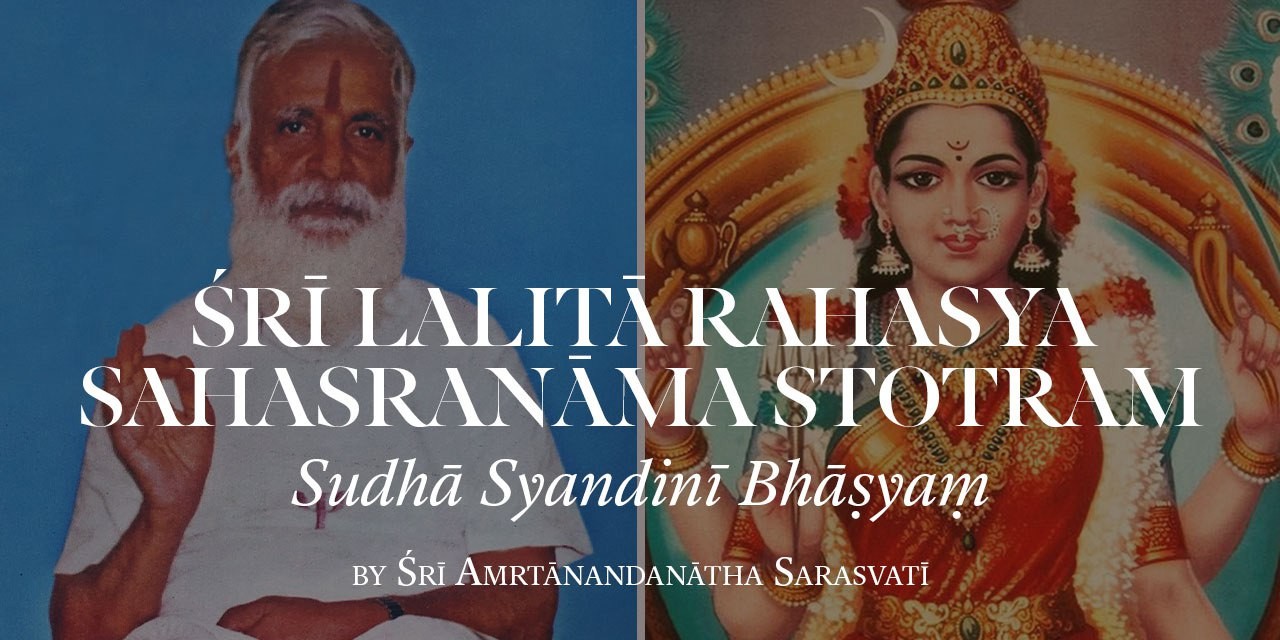
55) Sumeru-madhya-śṛṅgasthā
In the Mount Meru, there are four peaks, three at the three vertices of an isosceles triangle and one at the centre. The three peaks at the vertices are supposed to be the abodes of Brahmā, the Creator, Viṣṇu, the Sustainer and Śiva, the Destroyer of all the worlds, where they live with their consorts Sarasvatī, Lakṣmī, and Kālī. In the centre, Lalitā Mahā Tripurasundarī plays with Her consort Mahā Kāmeśvara.
This central peak is supposed to be 400,000 miles high. The whole place is filled with godly personages of all descriptions, singing and dancing in ecstasy of self realisation.
There is no contradiction in saying that Lalitā stays on the of lap of Kāmeśvara and then saying that She exists in the central peak of Mount Meru, because we are dealing with a transcendental phenomenon here. As explained already earlier, She exists in all persons, at all places, and at all times. The reason for mentioning these places then is that this reality can be more easily appreciated by contemplation of such places.
Mount Meru is the central triangle of the centre of Śrī Cakra. There is a well known form of Śrī Cakra called the Meru, in which successive enclosures rise one above the other like a pyramid culminating in a central peak. The Śrī Cakra represents the cosmos and also the individual on the three levels of waking, dreaming, sleeping and also on the transcendental level of superconsciousness. The regions of the body corresponding to these levels is indicated below in tabular form.

//////. MISING PAGE //////
[continued] …and flowing with time, loses the relative notion with respect to time, and time freezes, so does space freeze, and suddenly, one is in the transcendental superconscious state. You are there. That is Lalitā Mahā Tripurasundarī, in the lap of Mahā Kāmeśvara.
The illusion of body confinement is abandoned in moving from waking to dreaming state. This happens when Śakti, the vagina, moves upwards and crosses the navel centre. At the navel centre, Lalitā is known as Bālā or Durgā. The cosmic fires at the navel centre burn up the body and with it the sense of body identification. The Kuṇḍalinī which just started moving in the lower reaches of genitals is called Kumari, the five year old girl, unfit to be enjoyed. As Kuṇḍalinī whizzes past the neck centre called Viśuddhi, astral self projections cease, as one becomes space like. Here, Lalitā is Lakṣmī, imparting pure knowledge to the aspirant, teaching desirelessness.
As the Kuṇḍalinī rises further, a state of deep darkness is experienced. This happens not because there is no light there, but because our sensory apparatus called the mind is not yet tuned to see the supra-visual light that exists there. This state is a terrifying state, because all subconscious fears seize an individual who at the moment is suspended supportlessly. If one succumbs to the fears at this stage, one returns to square one, to start the journey all over again, or even to abandon meditation altogether. Unless one is able to surrender the mind, this stage is difficult to cross. This command for surrendering the mind is given at the center of eyebrows called the Ājñā cakra. The controlling goddess of this cakra is Sarasvatī who will come to the rescue, and tide you over the impasse.
Since it is difficult to surrender to the dark, unknown; Sarasvatī takes the form of Guru, to whom, it is relatively easier to surrender. In order to go from Ājñā to Sahasrāra, total surrender to the Guru is needed; of body, bind and soul. The most important of such surrenders is the surrender of the mind. Attentiveness to what the Guru says and absolute faith in his ability alone can move you from Ājñā to Sahasrāra. With the grace of the Guru, one gets beyond the darkness to see the light, glory, grace, charm, love, bliss and harmony of Śrī Lalitā Mahā Tripurasundarī. This final obstacle is called rudra granthi, as the earlier two are called brahmagranthi, and viṣṇugranthi. Granthi means a knot. These knots have to do with overcoming fears about loss of body, mind and life identities. Having scaled these three peaks, one enters the central final peak where Śrī Lalitā provides automatic lifts to reach Her without any more tarrying.
Source: Śrī Amṛtānandanātha Saraswatī "Sudhā Syandinī Bhāṣyaṃ" Typed Manuscript
(an incomplete commentary on Lalitā Sahasranāma)
